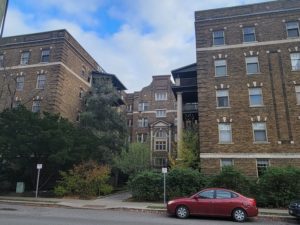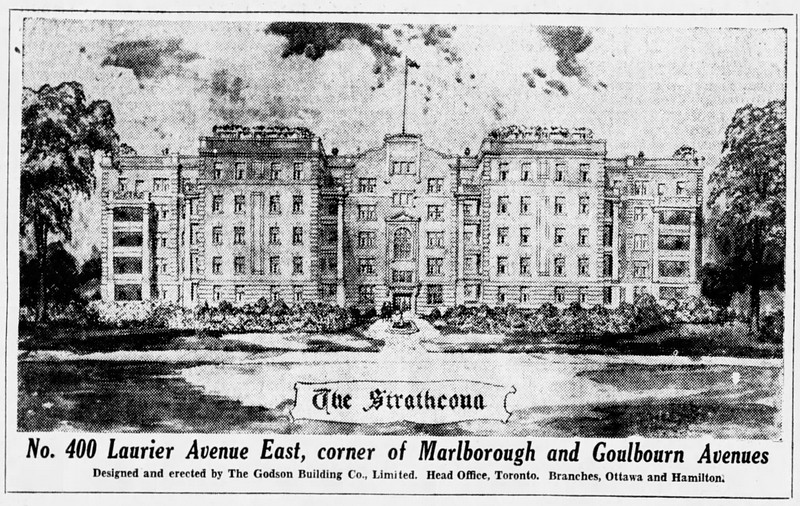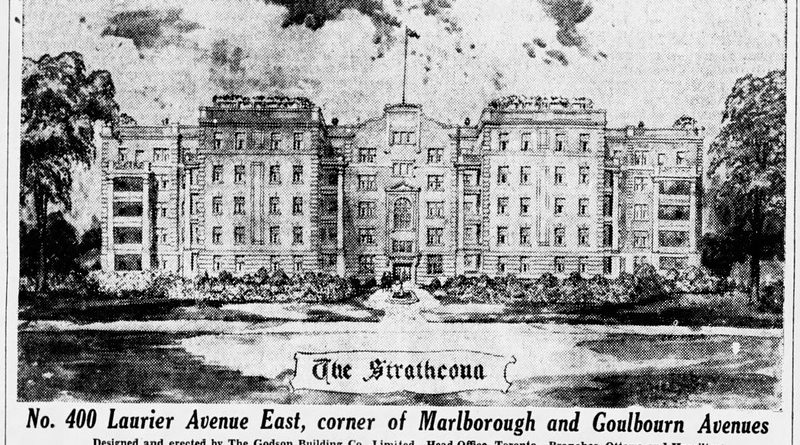Ken’s Bygone Sandy Hill
Storied storeys: Strathcona Apartments at 404 Laurier East
Ken Clavette

Photo: Ken Clavette
In November 1926, Mr. R. W. Godson, President of Godson Building Company Limited, appeared before city council and made a promise: “Ottawa is to have the largest and finest apartment house in Ontario,” he declared. The erection of the building would employ about 300 men he said and will mean $6,000 to $7,000 annually in civic taxes. The building he wanted to construct would be in Sandy Hill on Laurier Ave.
In August of 1927, an advertisement appeared in the Ottawa Citizen. The “Strathcona Apartments” were ready to accept tenants and offered the latest conveniences: electric refrigeration, continuous hot water, elevators, and garbage incinerators. There was an underground garage with car jockeys to park and retrieve cars, along with a car wash service as needed. The owners had hoped to install a gas station in the garage, but the city rejected it as contrary to the bylaws.
Units had a private balcony that would provide relief in Ottawa’s hot, humid summers. There were plans for an elaborate roof garden the design for which was modeled from the promenade deck of an ocean liner. Units could be rented furnished or unfurnished. Sizes ranged from studios and one-bedroom with bath up to seven rooms and two baths. A one room unit rented for $40 (equal to $708 in today’s value) while an apartment of 5 rooms could be had for $80 (equal to $1,416 today). There were 6 staff employed in the early years. One would start as a “coal boy” stoking the boilers in the basement and then move up to a car jockey; after that, one might graduate to building superintendent.
The timing of a new luxury apartment building could not have been worse. It opened on the eve of the 1929 crash and a decades long depression. A housing shortage in the city during the Second World War meant full occupancy, but the owners struggled with debit. In January 1942, the newspapers reported the Equitable Life Insurance Company was in court foreclosing on the mortgage, claiming the owners of the Strathcona’s owed them $621,594. The apartment building was now being run by a company that had hoped it could make a quick sale, but it was not to be. Five years later, they turned to their lawyer with a proposal: they wanted him to buy the building from them. Sam Berger was his name.
Sam was an Ottawa boy born on King Edward Ave in 1900, one of 8 children to Rabbi Joseph Berger. He was educated at the York Street school and then Lisgar Collegiate. He helped put himself through law school as a part-time police reporter for local newspapers. While practicing law, he got into real estate “almost by accident,” he told the Ottawa Citizen in 1977. “I was representing an insurance company in Ottawa, and they held the mortgage on the Strathcona Apartments on Laurier Ave, and they instructed me to foreclose. So I did.” However, they couldn’t sell the building. “So one fine day,” Berger explained, “…the president of the insurance company said to me, ‘Why don’t you buy it?’ I said what with?” They loaned him $25,000 to put down on it. The selling price was $216,470 and they gave him a mortgage. “It was all financed. I didn’t have any money of my own.” The Berger’s moved into the Strathcona, and two of their children were born in the building. They started off in a one-bedroom apartment, and as the family grew, they kept changing into larger units, ending up in the largest.
That real estate deal changed the direction of Sam’s life. He went from lawyer to property developer and owner. Over the coming years, his company, Ottawa Commercial Realty, owned and built many apartments, office buildings, and even owned a hotel. He became the General Manager then owner of the Ottawa Rough Riders, a team with seven cup appearances and four championships under his leadership. After he sold the team, he then bought the Montreal Alouettes.
There is a story his son David tells according to which, without his father, the Grey Cup might have remained tucked away in the basement of the Strathcona. As the story goes, fresh back from his war service, Berger discovered the cup in a storage locker underneath the Strathcona.
Sam served on city council and ran unsuccessfully against Charlotte Whitton for mayor in 1960 and 62.
In 1961 when he sold the Strathcona, a one-bedroom apartment was renting for between $90 and $95 and a 3 bedroom for $185 a month. The current buildings owner, Sandy Smallwood, described Sam this way, “the building built the man.”
The years between Sam and Sandy were some hard ones for a now aging building.
Sandy bought the building in 1992. Known as the heritage developer, he was approached by the building’s Tenant Association; they proposed that he should buy and save the building. He quickly found out that a previous owner had violated the rent control laws and had to compensate the tenants with upwards of $1 million and return the rents to a low level. With “Duct Tape” being a favourite tool for repair, the building had greatly deteriorated.
Sandy recalled how one senior government mandarin lived in a large apartment, had a chauffeur collect her each morning, but only paid rent of $1,500. However, it was not only the rich that lived in the Strathcona. Like Sandy Hill, the building was a mixed community. Rich people lived in the larger apartments, but there were studios and one-bedroom units with tenants of modest means. “The Strathcona has always been a popular building with artists,” said Smallwood.
In talking with Sandy, I was given a history lesson on the development of modern apartment buildings and how they serviced the needs of women. Boarding houses didn’t have a good reputation, but an apartment was a safe home for a single person and provided long term habitation. Some would live in the same building for up to 50 years. Today there are tenants in residence that where there before he purchased the building.
Sandy has become known as the developer that loves heritage buildings and hates sending them to the land fill. He helped save the Panet House on the corner of Laurier and King Edward, the Windsor Arms Apartments on Argyle, and led the Wallis House redevelopment. There are 1,000 windows in the buildings he owns, and everyone of them is worth saving, he told me. Repairing and replacing those large Strathcona balcony columns is enough work to employ a team of carpenters.
A 95-year-old building that has 100 units has many stories to tell of those that lived in it. The Strathcona has had a wide rage of tenants. Long before he became a famous Canadian business leader and horse breeder, owner of Northern Dancer, a young E.P., Taylor and his wife set up house there. Hewitt Bostock, Speaker of the Senate, was an early resident. During the war years, Royal Canadian Naval Reserve Commander Albert Robert Ernest Coleman and Squadron Leader C. E. Napier shared an apartment, as did many others. In 1953, Dr. Ephraim Herbert Coleman, Canada’s first ambassador to CUBA (1952), and his wife moved in after their posting to Brazil. Coleman was the public servant that organized the secret Quebec Conference in 1943 that brough Churchill and Roosevelt to Canada for a war leaders’ meeting hosted by Prime Minister King.
It was not only the leaders of industry and commerce that called the Strathcona home. The leader of the CCF, Major J. M. Coldwell, and his wife and daughter were tenants. Tommy Douglas and his wife Irma lived in apartment #108 for several years when he was first elected NDP leader in 1961.
Jacquelin Holzman (nee Greenberg), a future mayor of Ottawa, grew up in the Strathcona. A young Paul Dewar, who would go on to be a member of Parliament for Ottawa Centre, was the head of the Tenants Association when he lived there. His future wife Julia Sneyd was also a tenant in the building.
In 1955, Member of Parliament John Diefenbaker and wife Olive moved to the Strathcona Apartments where they lived until the following year when he became leader of the Progressive Conservative Party and leader of the official opposition. They lived in apartment 214, which had just been vacated by one-time Public Service union leader Frank Grierson (who was the subject of the cover story in the October-November issue of IMAGE).
For the record
The Strathcona is an exceptional example of the shift towards multiple unit residential that characterized early twentieth century redevelopment in Sandy hill. The more remarkable architectural features include monumental columns, supporting multi-level porches, an entrance courtyard with an elaborate frontispiece, the use of polychromatic masonry, and distinctive art glass windows
Designated Heritage by the City of Ottawa – March 2, 1994

Photo: Ottawa Citizen
